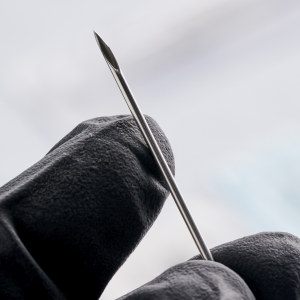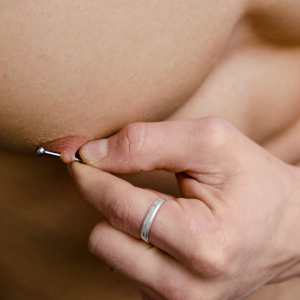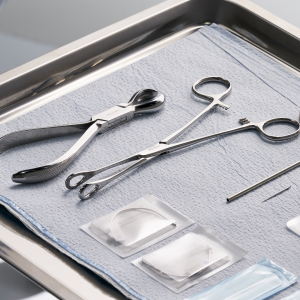Picking the right piercing needle matters, especially when it comes to gauge and piercing type. You probably already know—you chose this blog after all. But if you’re just starting out or simply looking to brush up, you might be asking yourself, “What should I actually be looking for when shopping for piercing needles?”
Let’s break it down so you can make the best (and safest) choice every time.
Types of Piercing Needles
 First things first: tri-bevel needles are the standard. They’re razor-sharp and designed to minimize trauma, which means a smoother process and faster healing. The three bevels—piercing, cutting, and stretching—work together to create a clean, precise hole in a single motion.
First things first: tri-bevel needles are the standard. They’re razor-sharp and designed to minimize trauma, which means a smoother process and faster healing. The three bevels—piercing, cutting, and stretching—work together to create a clean, precise hole in a single motion.
Want a deeper dive into how this works? Check out our blog here.
-
Straight Piercing Needles: Ideal for most piercings—easy to handle, accurate, and versatile for everything from lobes to navels.
-
Curved Piercing Needles: Helpful for angled or hard-to-reach placements like rooks, daiths, or select genital piercings. They follow the natural curve of the body to reduce trauma.
-
Cannula Piercing Needles: These feature a flexible plastic sheath that stays in the skin after the needle is removed, making jewelry insertion more controlled. Common in European practices and especially useful for a wide variety of piercings, including surface, genital, nipple, belly button, and various cartilage piercings where jewely insertion can be tricky.
- Hooked Needles: Brought to you by Brazilian piercer Ronaldo “Snoopy” Sampaio. An alternative to the popular curved needles, these have a gentle curve or “hook” at the end, which makes them ideal for piercing areas where a straight needle won’t cut it—like certain genital or surface piercings. They help you work with, not against, the body’s natural contours.
-
Play Piercing Needles: Designed for temporary use and specialized techniques. Learn more about them here.
A Note on Piercing Needle Material
Most piercing needles are made from medical-grade stainless steel. It’s strong, corrosion-resistant, and hypoallergenic. So, literally everything you want when working with skin and tissue. Consequently, when you’re shopping, stick with brands that are pre-sterilized, tri-beveled, and made with stainless steel. It’s the gold standard and most common choice for a reason.
 What Gauge Needle to Choose?
What Gauge Needle to Choose?
If you’re new to piercing or training to become a piercer, getting familiar with gauge sizes is a must.
Each piercing type has its own standard gauge range, but anatomy, client preferences, and older (or stretched) piercings can shift the game. That’s why it’s so important to match your needle gauge to your jewelry gauge—that’s how you prevent issues like migration, rejection, or delayed healing.
In general, your gauge should reflect the location of the piercing and how that tissue heals. Beyond that, aesthetics matter, too. While 20g and 18g used to be standard for earlobes, many piercers now opt for 16g or even 14g to accommodate bolder jewelry and style trends. Gotta stay current.
Some clients may also plan to stretch their piercings later on. If that’s the case, be ready to walk them through a safe, gradual process—or let them know if stretching isn’t advisable based on their anatomy or healing history.
For now, here’s a quick refresher on standard needle gauges by piercing type. Remember: these are standard, but there are always exceptions.
What Gauge Needle for Ear & Cartilage Piercings

-
Lobes: 20g or 18g
-
Cartilage (tragus, helix, forward helix, rook, anti-tragus, conch, daith): 18g or 16g
-
Industrial: Typically 14g
What Size Needle for Nose Piercings
-
Nostril: 20g or 18g
-
Septum: 14g
What Gauge Needle for Body Piercings

-
Navel, eyebrow, nipple, tongue: 14g is the most common
-
Lip, Philthrum, and Monroe: Usually 16g
- Cheek: 16g or 14g (sometimes 12g)
What Gauge Needle for Genital Piercings
Genital piercings can vary widely depending on anatomy and personal preference. Here’s a breakdown of common sizes for genital piercings:
-
Female Genital Piercings: Varies greatly depending on placement and individual anatomy (more details on these types of piercings in our blog here)
-
Male Genital Piercings: Varies greatly depending on placement and individual anatomy (more details on these types of piercings in our blog here)
For those just starting out with genital piercings, it’s crucial to pay close attention to your professional mentor and ask lots of questions. Genital piercings require a deep understanding of anatomy and sensitivity, so make sure you’re getting guidance from someone with plenty of experience. Safety, precision, and client comfort are the top priorities here.
Surface Piercings: Gauges for Dermals and Surface Bars

Surface piercings, including dermals, are a bit different from traditional piercings because they require precision and care in both placement and needle selection.
-
Dermal Piercings: 14g is the standard, though some piercers use 16g depending on the area. In rare cases, a 12g needle may be used depending on the anatomy of the piercing site and the jewelry choice.
-
Surface Bars: Typically use 14g needles for a proper fit, but always match the size of the needle to the surface bar jewelry you’re going to use.
For both surface piercings and dermals, proper aftercare and healing times can vary, so it’s important to guide clients accordingly.
A Close Look at All Standard Gauges by Piercing
Explore this blog dedicated to standard piercing sizes for extra details we didn’t cover in this guide.
What to Look for When Buying Piercing Needles – Your Official Checklist
Whether you’re new or stocking up, make sure your needles meet these standards:
✔️Sterile and Sealed – If it’s not individually sealed, it’s a no-go. Sterility is non-negotiable.
✔️Medical-Grade Steel – Strong, corrosion-resistant, and safe for skin. Pretty much the industry standard.
✔️Tri-Bevel Sharpness– You want smooth, precise piercings—not a jagged mess. Sharpness matters.
✔️Right Size for the Job – Make sure the needle gauge matches the jewelry you’re using. No guesswork here.
Precision Needles
Precision Piercing Needles tick all the boxes on your checklist. Medical-grade steel? Check. Individually sealed? Yep. Designed for clean, accurate piercings? Absolutely. Check out our full selection and start building out your piercing setup.Check out our full selection of them and start building your piercing setup.
Beyond the Needles
Need more than just needles? Check out our full selection of piercing supplies for a comprehensive setup.
We’ve got you covered with corks, skin markers, sterilization tools, and other medical supplies—everything you need to complete your piercing setup. Moreover, remember: you can always refer back to this guide whenever you’re stocking up or sizing up. Happy piercing!


Comments are closed here.